关于差异化营销策略研究的文献综述.
营销组合策略国内外文献综述
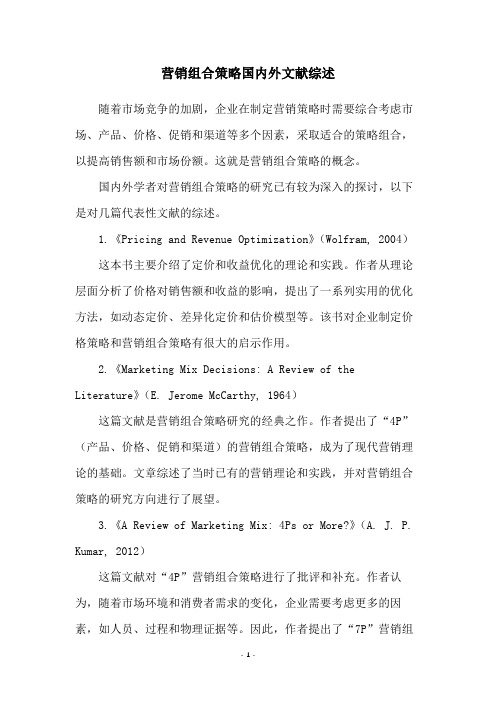
营销组合策略国内外文献综述随着市场竞争的加剧,企业在制定营销策略时需要综合考虑市场、产品、价格、促销和渠道等多个因素,采取适合的策略组合,以提高销售额和市场份额。
这就是营销组合策略的概念。
国内外学者对营销组合策略的研究已有较为深入的探讨,以下是对几篇代表性文献的综述。
1.《Pricing and Revenue Optimization》(Wolfram, 2004)这本书主要介绍了定价和收益优化的理论和实践。
作者从理论层面分析了价格对销售额和收益的影响,提出了一系列实用的优化方法,如动态定价、差异化定价和估价模型等。
该书对企业制定价格策略和营销组合策略有很大的启示作用。
2.《Marketing Mix Decisions: A Review of the Literature》(E. Jerome McCarthy, 1964)这篇文献是营销组合策略研究的经典之作。
作者提出了“4P”(产品、价格、促销和渠道)的营销组合策略,成为了现代营销理论的基础。
文章综述了当时已有的营销理论和实践,并对营销组合策略的研究方向进行了展望。
3.《A Review of Marketing Mix: 4Ps or More?》(A. J. P. Kumar, 2012)这篇文献对“4P”营销组合策略进行了批评和补充。
作者认为,随着市场环境和消费者需求的变化,企业需要考虑更多的因素,如人员、过程和物理证据等。
因此,作者提出了“7P”营销组合策略,即产品、价格、促销、渠道、人员、过程和物理证据。
4.《A Review of Marketing Mix: 4Ps or More?》(A. J. P. Kumar, 2012)这篇文献主要探讨了数字营销组合策略。
作者认为,在数字化时代,企业需要采用数字化营销手段来满足消费者的需求,如社交媒体营销、搜索引擎营销和电子邮件营销等。
文章还对数字营销策略与传统营销策略的优缺点进行了比较。
企业产品差异化的研究参考文献

企业产品差异化的研究参考文献企业产品差异化是企业在市场竞争中获得竞争优势的重要策略之一。
差异化产品可以帮助企业在同质化竞争中脱颖而出,满足不同消费者的需求,提高产品的市场竞争力。
本文将从不同维度探讨企业产品差异化的研究,参考文献如下:1. 王志宽,《论产品差异化战略下的市场竞争》(《西南交通大学学报》)此文章主要研究了在差异化战略下的市场竞争,论述了产品差异化的重要性以及产品差异化对企业竞争力的影响,以品牌差异化为例,分析了不同品牌差异化策略的效果。
文中提到,企业在市场竞争中通过产品差异化能够提高市场份额和利润,并给出了提高产品差异化的具体措施和建议。
2. 马瑞卿,《企业产品差异化策略研究》(《价值工程》)该文研究了企业产品差异化策略的实施和影响因素,通过实证研究得出了产品差异化对企业市场份额和利润的正向影响。
同时,文章还分析了企业产品差异化策略的局限性和挑战,提出了相应的应对措施和建议,如开展创新研发、加强品牌建设等。
3. 李健,《产品差异化技术研究》(《科技管理研究》)本文从技术角度研究了产品差异化策略,探讨了技术创新在产品差异化中的作用。
通过案例分析和实证研究,文章指出技术创新是实现产品差异化的重要手段,可以提高产品质量、功能和性能,从而满足消费者不同需求。
此外,文中还探讨了技术差异化对企业竞争力的影响,并提出了技术差异化实施的关键因素和注意事项。
4. 顾华,《企业产品差异化对竞争优势的影响研究》(《东北林业大学学报》)该文通过问卷调查和数据分析,研究了企业产品差异化对竞争优势的影响。
研究结果表明,企业产品差异化能够显著提高企业的市场地位和竞争优势,进而提高市场份额和利润。
文章还探讨了不同差异化策略对企业竞争优势的不同影响,并提出了差异化产品实施的管理策略和措施。
5. 郑文奇,《产品差异化策略对企业绩效的影响研究》(《科技进步与对策》)此文研究了产品差异化策略对企业绩效的影响,并通过案例分析和实证研究验证了产品差异化对企业绩效的积极影响。
战略,差异化战略和市场营销策略的相关文献综述
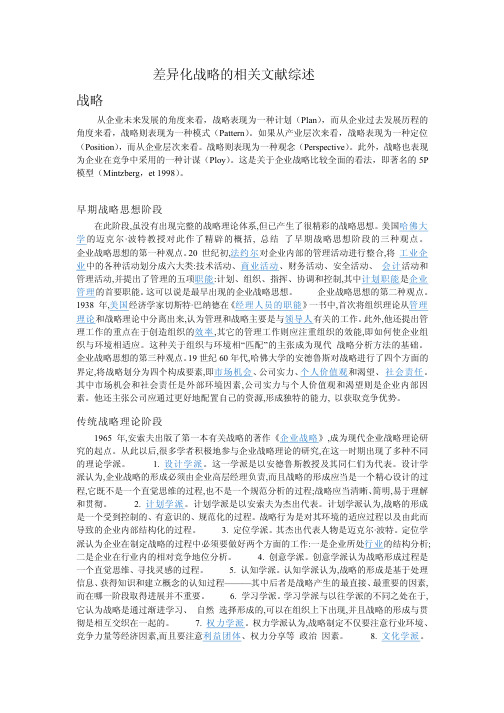
段阶 论理 略战 统 传
。势优争竞取获以 ,力能的特独成形,源资的己自置配地好更过通应司公张主还他。素 因部 内业企是 则望渴和 观值价人个与 力实 司公 , 素因境环 部外是任 责会社和会机场市中 其 。 任 责 会 社 、望渴和 观 值 价 人 个 、力实司公 、 会 机 场 市即,素要成构个四为分划略战将,定界 的面方个四了行进略战对斯鲁德安的学大佛哈,代年 06 纪世 91 。点观种三第的想思略战业企 。 础 基 的 法 方 析 分 略 战 代 现 为 成 张 主的 ” 配 匹 “ 相 境 环 与 织 组 于 关 种 这 。 应 适 相 境 环 与 织 组业企使何如即, 能效的织组重注应则作工理管的它其, 率 效的织组造创于在点重的作工理 管出提还他,外此 。作工的关有 人 导 领与是要主略战和理管为认,来出离分中论理略战和 论 理 理 管从论理织组将次首,中书一 》 能 职 的 员 人 理 经《 在德纳巴·特斯切家学济经 国 美,年 8391 。点观种二第的想思略战业企 。想思略战业企的现出早最是说以可这 。能职要首的 理 管 业 企是 能 职 划 计中其,制控和调协、挥指、织组、划计: 能 职项五的理管了出提并,动活理管 和动活 计 会 、动活全安、动活务财、 动 活 业 商、动活术技:类大六成分划动活种各的中 业 企 业 工 将,合整行进动活理管的部内业企对 尔 约 法,初纪世 02 。点观种一第的想思略战业企 。 点观种 三的段 阶想思略 战期早 了 结总 , 括 概的辟 精了作此 对授教特 波·尔 克迈的 学 大 佛 哈国美。想思略战的彩精很了生产已但,系体论理略战的整完现出有没虽,段阶此在
段阶 论理 略战 争 竞
。系体的 成而合综点观的派学种各它其由———合整种一是成看定制略战把;体机有的成组征特和为 行列系一由———构结种一是成看织组业企把派学构结。 派 学 构 结 .01 。素因境环注 关们人让种一了到起过不用作的起所其,展发和存生得获何如里境环的处所其在织组业企是 的调强派学境环。派学境环 .9 。程过的用作挥发以合整行进素因的益有种各中织组业 企将个一是程过成形其, 念 观 值 价会社的后背其及 化 文 业 企于植根略战业企,为认派学化文
差异化战略文献综述
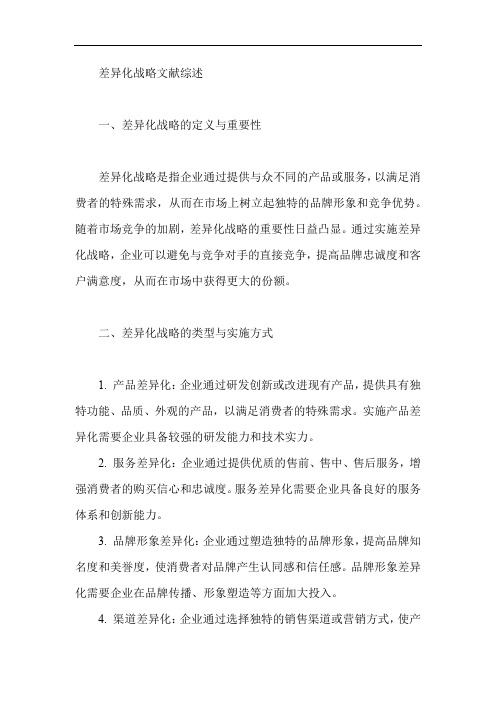
差异化战略文献综述一、差异化战略的定义与重要性差异化战略是指企业通过提供与众不同的产品或服务,以满足消费者的特殊需求,从而在市场上树立起独特的品牌形象和竞争优势。
随着市场竞争的加剧,差异化战略的重要性日益凸显。
通过实施差异化战略,企业可以避免与竞争对手的直接竞争,提高品牌忠诚度和客户满意度,从而在市场中获得更大的份额。
二、差异化战略的类型与实施方式1. 产品差异化:企业通过研发创新或改进现有产品,提供具有独特功能、品质、外观的产品,以满足消费者的特殊需求。
实施产品差异化需要企业具备较强的研发能力和技术实力。
2. 服务差异化:企业通过提供优质的售前、售中、售后服务,增强消费者的购买信心和忠诚度。
服务差异化需要企业具备良好的服务体系和创新能力。
3. 品牌形象差异化:企业通过塑造独特的品牌形象,提高品牌知名度和美誉度,使消费者对品牌产生认同感和信任感。
品牌形象差异化需要企业在品牌传播、形象塑造等方面加大投入。
4. 渠道差异化:企业通过选择独特的销售渠道或营销方式,使产品或服务在市场上形成竞争优势。
渠道差异化需要企业根据产品特点、目标市场等因素进行合理的渠道规划和布局。
三、差异化战略的优势与挑战1. 优势:差异化战略可以使企业在市场上树立独特的形象和品牌声誉,提高消费者对产品的认知度和忠诚度;同时,通过满足消费者的特殊需求,企业可以获得更高的市场份额和更多的利润空间。
2. 挑战:实施差异化战略需要企业具备较强的创新能力和技术实力,同时需要投入大量的资源进行品牌建设和市场推广;此外,由于差异化战略需要针对消费者的特殊需求进行定制化生产或服务,可能会增加生产成本和运营难度。
四、差异化战略与企业绩效的关系差异化战略的实施与企业绩效之间存在密切的关系。
多数研究表明,实施差异化战略的企业在市场占有率、利润率等方面表现更优。
这是因为差异化战略能够使企业更好地满足消费者的需求,提高品牌忠诚度和客户满意度,从而增加市场份额和销售额。
营销策略国外文献综述范文
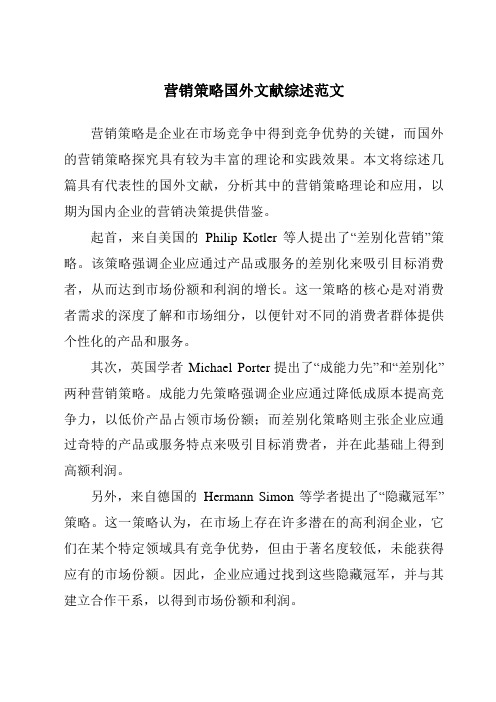
营销策略国外文献综述范文营销策略是企业在市场竞争中得到竞争优势的关键,而国外的营销策略探究具有较为丰富的理论和实践效果。
本文将综述几篇具有代表性的国外文献,分析其中的营销策略理论和应用,以期为国内企业的营销决策提供借鉴。
起首,来自美国的Philip Kotler等人提出了“差别化营销”策略。
该策略强调企业应通过产品或服务的差别化来吸引目标消费者,从而达到市场份额和利润的增长。
这一策略的核心是对消费者需求的深度了解和市场细分,以便针对不同的消费者群体提供个性化的产品和服务。
其次,英国学者Michael Porter提出了“成能力先”和“差别化”两种营销策略。
成能力先策略强调企业应通过降低成原本提高竞争力,以低价产品占领市场份额;而差别化策略则主张企业应通过奇特的产品或服务特点来吸引目标消费者,并在此基础上得到高额利润。
另外,来自德国的Hermann Simon等学者提出了“隐藏冠军”策略。
这一策略认为,在市场上存在许多潜在的高利润企业,它们在某个特定领域具有竞争优势,但由于著名度较低,未能获得应有的市场份额。
因此,企业应通过找到这些隐藏冠军,并与其建立合作干系,以得到市场份额和利润。
此外,来自日本的竹下登等学者提出了“服务营销”策略。
这一策略认为,企业应将服务作为核心竞争力,通过提供优质的售前、售中和售后服务,满足消费者的需求,提高客户满足度和忠诚度。
综上所述,国外的营销策略探究涵盖了差别化营销、成能力先、隐藏冠军和服务营销等多个方面。
这些策略在理论上提供了丰富的思路和方法,同时也在实践中取得了一定的成功。
国内企业在制定营销策略时,可以借鉴这些理论和实践效果,结合本土市场状况,提高市场竞争力和盈利能力。
营销策略研究 文献综述
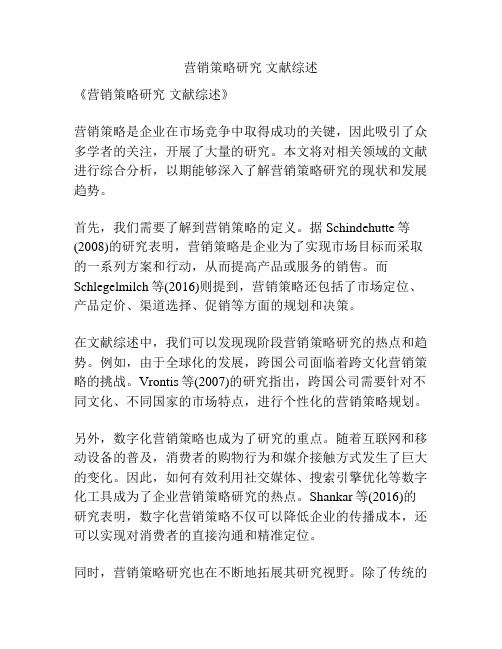
营销策略研究文献综述《营销策略研究文献综述》营销策略是企业在市场竞争中取得成功的关键,因此吸引了众多学者的关注,开展了大量的研究。
本文将对相关领域的文献进行综合分析,以期能够深入了解营销策略研究的现状和发展趋势。
首先,我们需要了解到营销策略的定义。
据Schindehutte等(2008)的研究表明,营销策略是企业为了实现市场目标而采取的一系列方案和行动,从而提高产品或服务的销售。
而Schlegelmilch等(2016)则提到,营销策略还包括了市场定位、产品定价、渠道选择、促销等方面的规划和决策。
在文献综述中,我们可以发现现阶段营销策略研究的热点和趋势。
例如,由于全球化的发展,跨国公司面临着跨文化营销策略的挑战。
Vrontis等(2007)的研究指出,跨国公司需要针对不同文化、不同国家的市场特点,进行个性化的营销策略规划。
另外,数字化营销策略也成为了研究的重点。
随着互联网和移动设备的普及,消费者的购物行为和媒介接触方式发生了巨大的变化。
因此,如何有效利用社交媒体、搜索引擎优化等数字化工具成为了企业营销策略研究的热点。
Shankar等(2016)的研究表明,数字化营销策略不仅可以降低企业的传播成本,还可以实现对消费者的直接沟通和精准定位。
同时,营销策略研究也在不断地拓展其研究视野。
除了传统的市场营销策略之外,社会营销策略、环保营销策略等新兴领域也吸引了学者的关注。
Maibach等(2006)的研究指出,社会营销策略可以通过改变社会行为和价值观,从而推动社会的整体变革。
总之,营销策略研究是一个不断发展、变化的领域,而且在全球化、数字化和社会化的趋势下,其研究领域还将更加广阔。
希望通过对相关文献的综合分析,能够为未来的营销策略研究提供一些新的思路和方法。
企业产品差异化的研究参考文献
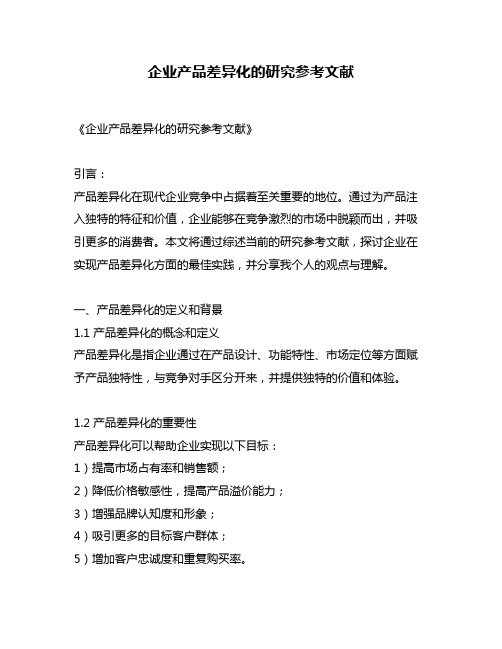
企业产品差异化的研究参考文献《企业产品差异化的研究参考文献》引言:产品差异化在现代企业竞争中占据着至关重要的地位。
通过为产品注入独特的特征和价值,企业能够在竞争激烈的市场中脱颖而出,并吸引更多的消费者。
本文将通过综述当前的研究参考文献,探讨企业在实现产品差异化方面的最佳实践,并分享我个人的观点与理解。
一、产品差异化的定义和背景1.1 产品差异化的概念和定义产品差异化是指企业通过在产品设计、功能特性、市场定位等方面赋予产品独特性,与竞争对手区分开来,并提供独特的价值和体验。
1.2 产品差异化的重要性产品差异化可以帮助企业实现以下目标:1)提高市场占有率和销售额;2)降低价格敏感性,提高产品溢价能力;3)增强品牌认知度和形象;4)吸引更多的目标客户群体;5)增加客户忠诚度和重复购买率。
二、产品差异化的实施策略2.1 产品特性的差异化企业可以通过产品的功能、设计、外观、质量等方面实现差异化。
苹果公司以其独特的设计和用户友好的界面在智能手机市场取得了巨大的成功。
2.2 市场定位的差异化企业可以通过树立不同的市场定位来实现产品差异化。
一些企业将自身定位为高端市场,而另一些企业则致力于服务大众市场。
2.3 服务体验的差异化除了产品本身,企业还可以通过提供卓越的售后服务、个性化的定制服务等来实现差异化。
优质的服务体验可以为消费者带来额外的价值感,进而提高他们对产品的满意度和忠诚度。
三、产品差异化的案例研究3.1 苹果公司的产品差异化策略苹果公司凭借其创新、独特和高品质的产品成功地实现了差异化竞争。
其产品设计简洁而精致,易于使用,符合用户需求。
苹果专注于提供卓越的用户体验和无缝的生态系统,进一步增强了其差异化竞争优势。
3.2 耐克公司的品牌差异化策略耐克公司通过建立强大且具有辨识度的品牌形象,成功地实现了产品的差异化。
耐克在市场上不断传递着“Just Do It”的品牌价值观,通过赞助体育赛事、签约明星代言人等方式为其产品注入了更多的情感价值和社会影响力。
营销策略文献综述

营销策略文献综述引言营销策略是企业在市场竞争中取得成功的重要因素之一。
随着市场环境的不断变化,营销策略也在不断演进和调整。
本文将综述当前文献中关于营销策略的相关研究,并分析不同的营销策略对企业业绩的影响。
营销策略的定义与分类营销策略是企业运用各种营销手段和方法,在市场中开展推广销售活动的计划和行动。
根据目标客户的不同需求和市场竞争的特点,营销策略可以分为以下几类:1.产品策略:包括产品定位、产品分类、产品差异化等方面的策略。
2.价格策略:包括定价策略、促销策略、折扣策略等方面的策略。
3.渠道策略:包括渠道布局、渠道选择、渠道合作等方面的策略。
4.推广策略:包括广告宣传、促销活动、公关活动等方面的策略。
营销策略对企业业绩的影响研究表明,有效的营销策略对企业的业绩有着重要的影响。
以下是一些常见的营销策略及其对企业业绩的影响:1.产品定位策略:通过明确定位产品的目标客户群体和产品的核心竞争优势,可以提高产品销售量和市场份额。
2.价格策略:合理定价能够吸引更多的消费者,提高产品的竞争力和市场份额。
3.渠道策略:选择适合的渠道可以使产品更快地进入市场,提高销售速度和销售额。
4.推广策略:有效地宣传和促销可以提高产品的知名度和消费者的购买欲望,进而增加销售量和市场份额。
营销策略的案例分析苹果公司的营销策略苹果公司一直以来都以其差异化的产品和创新的营销策略而闻名。
苹果公司通过产品创新和宣传推广的方式,成功地打造了强烈的品牌形象和忠诚的用户群体,从而保持了持续的销售增长和高利润率。
宝洁公司的营销策略宝洁公司注重产品定位和市场细分,通过不同的品牌和产品线满足不同消费者群体的需求。
宝洁公司还通过广告和促销活动强化了产品的品牌形象,提高了产品的市场占有率和销售额。
结论营销策略是企业成功的重要保障之一。
通过合理的产品、价格、渠道和推广策略,企业可以提高产品的竞争力和市场份额,从而实现业绩的提升。
然而,市场环境的不断变化和竞争的加剧也要求企业不断调整和优化营销策略,以适应市场的需求变化。
论文营销策略的文献综述
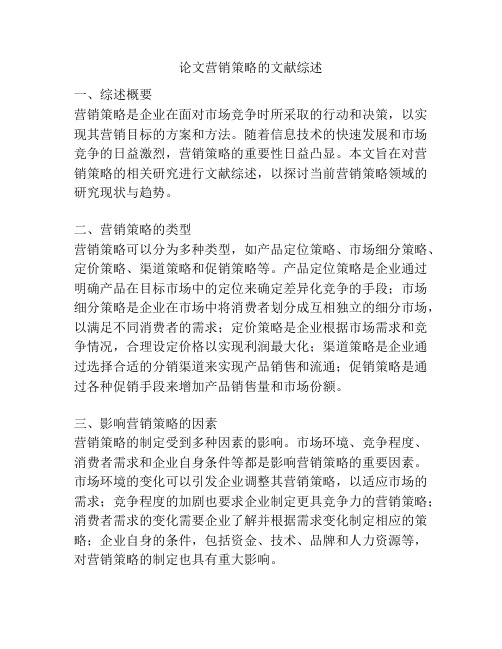
论文营销策略的文献综述一、综述概要营销策略是企业在面对市场竞争时所采取的行动和决策,以实现其营销目标的方案和方法。
随着信息技术的快速发展和市场竞争的日益激烈,营销策略的重要性日益凸显。
本文旨在对营销策略的相关研究进行文献综述,以探讨当前营销策略领域的研究现状与趋势。
二、营销策略的类型营销策略可以分为多种类型,如产品定位策略、市场细分策略、定价策略、渠道策略和促销策略等。
产品定位策略是企业通过明确产品在目标市场中的定位来确定差异化竞争的手段;市场细分策略是企业在市场中将消费者划分成互相独立的细分市场,以满足不同消费者的需求;定价策略是企业根据市场需求和竞争情况,合理设定价格以实现利润最大化;渠道策略是企业通过选择合适的分销渠道来实现产品销售和流通;促销策略是通过各种促销手段来增加产品销售量和市场份额。
三、影响营销策略的因素营销策略的制定受到多种因素的影响。
市场环境、竞争程度、消费者需求和企业自身条件等都是影响营销策略的重要因素。
市场环境的变化可以引发企业调整其营销策略,以适应市场的需求;竞争程度的加剧也要求企业制定更具竞争力的营销策略;消费者需求的变化需要企业了解并根据需求变化制定相应的策略;企业自身的条件,包括资金、技术、品牌和人力资源等,对营销策略的制定也具有重大影响。
四、营销策略的实施与评估营销策略不仅仅是制定出来,还需要进行实施与评估。
只有落实到具体的行动上,并通过定期的评估与分析来进行修正和优化,才能实现预期的效果。
营销策略的实施涉及到销售、广告推广、市场调研和客户关系管理等方面的工作;评估的主要目标是通过分析销售额、市场份额、顾客满意度和竞争力等指标来判断营销策略的有效性,并作出相应的调整。
五、未来趋势与挑战随着互联网的普及和数字化营销的兴起,未来的营销策略可能会更加注重创新、个性化和数字化营销。
互联网和社交媒体的出现为企业与消费者之间的直接沟通提供了便利,企业可以更加精准地了解消费者需求,并提供个性化的产品和服务。
关于营销策略研究的文献综述

关于营销策略研究的文献综述
文献综述是对某一方面的专题搜集大量情报资料后经综合分析
而写成的一种学术论文,它是科学文献的一种。
格式与写法
文献综述的格式与一般研究性论文的格式有所不同。
这是因为研究性的论文注重研究的方法和结果,特别是阳性结果,而文献综述要求向读者介绍与主题有关的详细资料、动态、进展、展望以及对以上方面的评述。
因此文献综述的格式相对多样,但总的来说,一般都包含以下四部分:即前言、主题、总结和参考文献。
撰写文献综述时可按这四部分拟写提纲,在根据提纲进行撰写工。
前言部分,主要是说明写作的目的,介绍有关的概念及定义以及综述的范围,扼要说明有关主题的现状或争论焦点,使读者对全文要叙述的问题有一个初步的轮廓。
主题部分,是综述的主体,其写法多样,没有固定的格式。
可按年代顺序综述,也可按不同的问题进行综述,还可按不同的观点进行比较综述,不管用那一种格式综述,都要将所搜集到的文献资料归纳、整理及分析比较,阐明有关主题的历史背景、现状和发展方向,以及对这些问题的评述,主题部分应特别注意代表性强、具有科学性和创造性的文献引用和评述。
总结部分,与研究性论文的小结有些类似,将全文主题进行扼要总结,对所综述的主题有研究的作者,最好能提出自己的见解。
参考
文献虽然放在文末,但却是文献综述的重要组成部分。
因为它不仅表示对被引用文献作者的尊重及引用文献的依据,而且为读者深入探讨有关问题提供了文献查找线索。
因此,应认真对待。
参考文献的编排应条目清楚,查找方便,内容准确无误。
关于参考文献的使用方法,录著项目及格式与研究论文相同,不再重复。
市场营销策略的文献综述

市场营销策略的文献综述市场营销策略的文献综述市场营销策略是企业在面对竞争激烈的市场环境中,为了实现公司目标而制定的一系列计划和行动。
通过有效的市场营销策略,企业能够增加销售额,提高市场份额,增强竞争优势。
本文将对市场营销策略的研究进行综述,从不同角度探讨其相关内容。
首先,市场定位是制定市场营销策略的重要步骤。
定位不仅指明了产品或服务将针对的目标市场,还决定了如何与竞争对手区分开来。
陈东(2017)的研究发现,在市场定位方面,差异化定位往往比低成本定位更能获得市场份额。
市场定位是市场营销策略的基础,企业需要准确把握目标市场的需求与竞争状况,以便进行进一步的策划和实施。
其次,产品策略是市场营销中的重要组成部分。
产品策略主要包括产品设计、产品定价、产品品牌等。
田智荣(2018)的研究指出,创新的产品设计可以通过与消费者互动和持续创新来提高市场竞争力。
产品定价策略是企业在市场上设置产品价格的决策,它可以直接影响消费者的购买行为。
品牌战略则通过建立和维护强大的品牌形象来吸引和保持消费者的忠诚度。
再次,推广策略是市场营销过程中不可或缺的一部分。
企业通过推广策略向目标市场传递产品或服务的信息,促进销售量的增加。
市场推广可以通过广告、促销活动、公关等方式进行。
促销策略的有效性对于市场营销策略的成功至关重要。
李文航(2019)的研究显示,个性化推广策略在提高消费者购买意愿和忠诚度方面具有重要作用。
最后,渠道策略是市场营销中的另一个关键要素。
渠道策略决定了企业如何将产品或服务送达客户。
选择适当的渠道可以提高产品的可及性和消费者的满意度。
王潇(2016)的研究指出,采用多渠道销售策略可以扩大市场覆盖面,提高销售效果。
与此同时,企业还需要与渠道成员进行有效合作,以确保产品能够顺利地到达最终用户。
综上所述,市场营销策略是企业实现市场目标的重要手段。
准确的市场定位、创新的产品策略、有效的推广策略和适当的渠道策略是市场营销策略实施的关键要素。
从“85度C”看品牌精细差异化营销【文献综述】
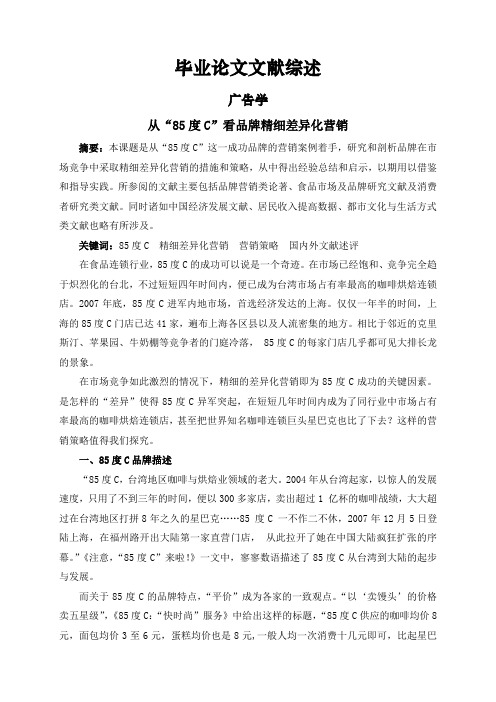
毕业论文文献综述广告学从“85度C”看品牌精细差异化营销摘要:本课题是从“85度C”这一成功品牌的营销案例着手,研究和剖析品牌在市场竞争中采取精细差异化营销的措施和策略,从中得出经验总结和启示,以期用以借鉴和指导实践。
所参阅的文献主要包括品牌营销类论著、食品市场及品牌研究文献及消费者研究类文献。
同时诸如中国经济发展文献、居民收入提高数据、都市文化与生活方式类文献也略有所涉及。
关键词:85度C 精细差异化营销营销策略国内外文献述评在食品连锁行业,85度C的成功可以说是一个奇迹。
在市场已经饱和、竞争完全趋于炽烈化的台北,不过短短四年时间内,便已成为台湾市场占有率最高的咖啡烘焙连锁店。
2007年底,85度C进军内地市场,首选经济发达的上海。
仅仅一年半的时间,上海的85度C门店已达41家,遍布上海各区县以及人流密集的地方。
相比于邻近的克里斯汀、苹果园、牛奶棚等竞争者的门庭冷落, 85度C的每家门店几乎都可见大排长龙的景象。
在市场竞争如此激烈的情况下,精细的差异化营销即为85度C成功的关键因素。
是怎样的“差异”使得85度C异军突起,在短短几年时间内成为了同行业中市场占有率最高的咖啡烘焙连锁店,甚至把世界知名咖啡连锁巨头星巴克也比了下去?这样的营销策略值得我们探究。
一、85度C品牌描述“85度C,台湾地区咖啡与烘焙业领域的老大。
2004年从台湾起家,以惊人的发展速度,只用了不到三年的时间,便以300多家店,卖出超过1 亿杯的咖啡战绩,大大超过在台湾地区打拼8年之久的星巴克……85 度C 一不作二不休,2007年12月5日登陆上海,在福州路开出大陆第一家直营门店,从此拉开了她在中国大陆疯狂扩张的序幕。
”《注意,“85度C”来啦!》一文中,寥寥数语描述了85度C从台湾到大陆的起步与发展。
而关于85度C的品牌特点,“平价”成为各家的一致观点。
“以‘卖馒头’的价格卖五星级”,《85度C:“快时尚”服务》中给出这样的标题,“85度C供应的咖啡均价8元,面包均价3至6元,蛋糕均价也是8元,一般人均一次消费十几元即可,比起星巴克或其他同类连锁店动辄人均消费上百元,85度C的价格基本属于馒头价位。
营销策略文献综述
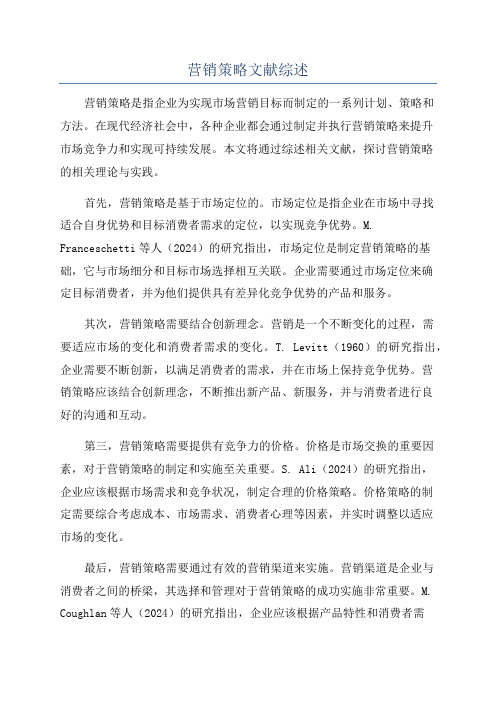
营销策略文献综述营销策略是指企业为实现市场营销目标而制定的一系列计划、策略和方法。
在现代经济社会中,各种企业都会通过制定并执行营销策略来提升市场竞争力和实现可持续发展。
本文将通过综述相关文献,探讨营销策略的相关理论与实践。
首先,营销策略是基于市场定位的。
市场定位是指企业在市场中寻找适合自身优势和目标消费者需求的定位,以实现竞争优势。
M. Franceschetti等人(2024)的研究指出,市场定位是制定营销策略的基础,它与市场细分和目标市场选择相互关联。
企业需要通过市场定位来确定目标消费者,并为他们提供具有差异化竞争优势的产品和服务。
其次,营销策略需要结合创新理念。
营销是一个不断变化的过程,需要适应市场的变化和消费者需求的变化。
T. Levitt(1960)的研究指出,企业需要不断创新,以满足消费者的需求,并在市场上保持竞争优势。
营销策略应该结合创新理念,不断推出新产品、新服务,并与消费者进行良好的沟通和互动。
第三,营销策略需要提供有竞争力的价格。
价格是市场交换的重要因素,对于营销策略的制定和实施至关重要。
S. Ali(2024)的研究指出,企业应该根据市场需求和竞争状况,制定合理的价格策略。
价格策略的制定需要综合考虑成本、市场需求、消费者心理等因素,并实时调整以适应市场的变化。
最后,营销策略需要通过有效的营销渠道来实施。
营销渠道是企业与消费者之间的桥梁,其选择和管理对于营销策略的成功实施非常重要。
M. Coughlan等人(2024)的研究指出,企业应该根据产品特性和消费者需求来选择最合适的营销渠道,并通过渠道管理来提升产品的销售和品牌形象。
综上所述,营销策略是企业实现市场营销目标的重要手段,它需要基于市场定位、结合创新理念、提供有竞争力的价格,并通过有效的营销渠道来实施。
未来的研究可以探讨营销策略在不同行业和国际市场中的应用及效果,以及在数字化时代的新挑战和机遇下如何制定和实施营销策略。
关于差异化营销策略研究的文献综述
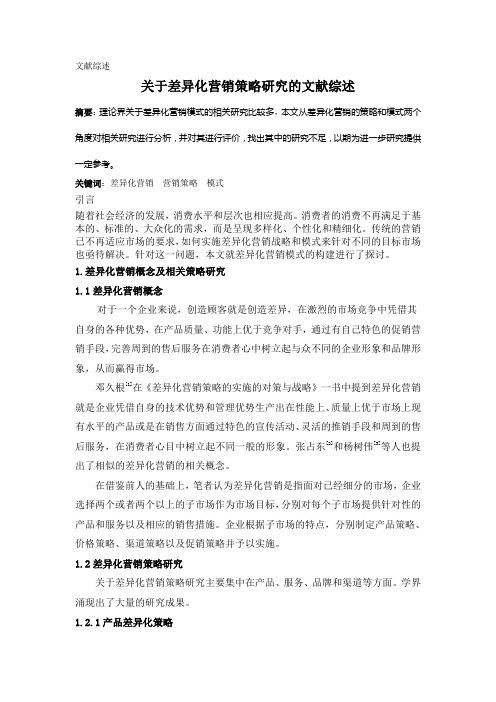
文献综述关于差异化营销策略研究的文献综述摘要:理论界关于差异化营销模式的相关研究比较多,本文从差异化营销的策略和模式两个角度对相关研究进行分析,并对其进行评价,找出其中的研究不足,以期为进一步研究提供一定参考。
关键词:差异化营销营销策略模式引言随着社会经济的发展,消费水平和层次也相应提高。
消费者的消费不再满足于基本的、标准的、大众化的需求,而是呈现多样化、个性化和精细化。
传统的营销已不再适应市场的要求,如何实施差异化营销战略和模式来针对不同的目标市场也亟待解决。
针对这一问题,本文就差异化营销模式的构建进行了探讨。
1.差异化营销概念及相关策略研究1.1差异化营销概念对于一个企业来说,创造顾客就是创造差异,在激烈的市场竞争中凭借其自身的各种优势,在产品质量、功能上优于竞争对手,通过有自己特色的促销营销手段,完善周到的售后服务在消费者心中树立起与众不同的企业形象和品牌形象,从而赢得市场。
邓久根[1]在《差异化营销策略的实施的对策与战略》一书中提到差异化营销就是企业凭借自身的技术优势和管理优势生产出在性能上、质量上优于市场上现有水平的产品或是在销售方面通过特色的宣传活动、灵活的推销手段和周到的售后服务,在消费者心目中树立起不同一般的形象。
张占东[2]和杨树伟[3]等人也提出了相似的差异化营销的相关概念。
在借鉴前人的基础上,笔者认为差异化营销是指面对已经细分的市场,企业选择两个或者两个以上的子市场作为市场目标,分别对每个子市场提供针对性的产品和服务以及相应的销售措施。
企业根据子市场的特点,分别制定产品策略、价格策略、渠道策略以及促销策略并予以实施。
1.2差异化营销策略研究关于差异化营销策略研究主要集中在产品、服务、品牌和渠道等方面。
学界涌现出了大量的研究成果。
1.2.1产品差异化策略产品差异化是指产品的特征、工作性能、一致性、耐用性、可靠性、易修理性、式样和设计等方面的差异。
其缺点是保持产品的差异化往往以高成本为代价,因为企业需要进行广泛的研究开发、产品设计、高质量原料和争取顾客支持等工作。
XXX营销策略分析-XXX营销策略的文献综述
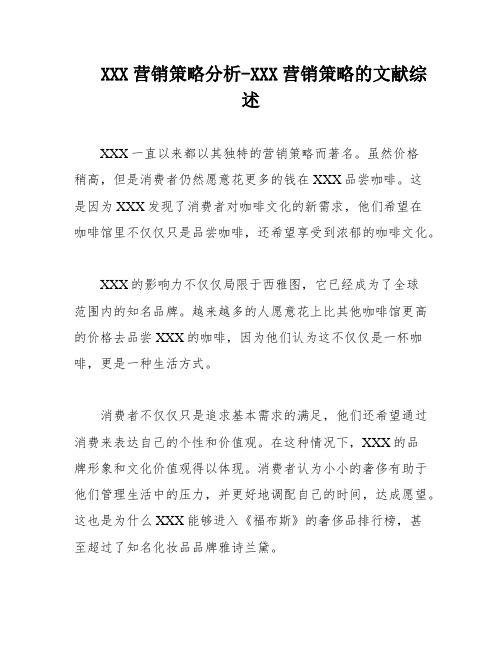
XXX营销策略分析-XXX营销策略的文献综述XXX一直以来都以其独特的营销策略而著名。
虽然价格稍高,但是消费者仍然愿意花更多的钱在XXX品尝咖啡。
这是因为XXX发现了消费者对咖啡文化的新需求,他们希望在咖啡馆里不仅仅只是品尝咖啡,还希望享受到浓郁的咖啡文化。
XXX的影响力不仅仅局限于西雅图,它已经成为了全球范围内的知名品牌。
越来越多的人愿意花上比其他咖啡馆更高的价格去品尝XXX的咖啡,因为他们认为这不仅仅是一杯咖啡,更是一种生活方式。
消费者不仅仅只是追求基本需求的满足,他们还希望通过消费来表达自己的个性和价值观。
在这种情况下,XXX的品牌形象和文化价值观得以体现。
消费者认为小小的奢侈有助于他们管理生活中的压力,并更好地调配自己的时间,达成愿望。
这也是为什么XXX能够进入《福布斯》的奢侈品排行榜,甚至超过了知名化妆品品牌雅诗兰黛。
1983年,XXX的前任总裁XXX在米兰参加商展时发现了意大利的咖啡文化。
他意识到,放松的气氛、交谊的空间、心情的转换,才是咖啡馆真正吸引顾客一来再来的精髓。
于是他把XXX打造成办公室和家以外的第三空间,让消费者在繁忙生活中也能感受片刻浪漫和新奇。
虽然XXX已经成为了一个成功的品牌,但是他们仍然需要不断地发现潜在的那些“第三空间”,以保持品牌的影响力。
XXX早在选址阶段就开始了发现消费者新需求的工作。
在中国,XXX选择在商业区落户,因为白领们更需要和更容易接受咖啡饮品,同时他们也更需要有一个调节压力的“驿站”。
而在欧美,人们在家里就有喝咖啡的惯,XXX要满足的是人们走出家庭之外享受咖啡的需求,因此那里的XXX主要集中于社区。
在北京,XXX甚至在道路两边各开一家,以便让人们省去过马路的麻烦,或者一家店里客人多没有空位的无奈。
虽然这样做,有时会导致单一店铺的经营业绩下降,但从整体上看,XXX的收入增加了。
在北京,XXX的发烧友都对XXX摇曳的灯光、舒缓的音乐非常熟悉。
除此之外,“XXX各分店每周必须为顾客开设一次咖啡讲座。
营销策略文献综述

营销策略文献综述摘要营销策略是企业发展和竞争的关键因素之一。
本文通过对营销策略领域的文献研究进行综合分析,总结了营销策略的定义、重要性以及常见的营销策略类型。
同时,本文还对营销策略的实施过程以及影响营销策略成功的因素进行了探讨。
最后,本文展望了未来营销策略研究的发展方向。
1. 引言营销策略是企业根据市场需求和竞争环境制定的一系列行动计划,旨在推动销售和市场份额的增长。
营销策略的制定涉及市场定位、目标市场的选择、产品策略、定价策略、渠道策略以及促销策略等方面的决策。
近年来,随着市场竞争的加剧和消费者需求的变化,营销策略的研究和实施变得愈发重要。
2. 营销策略的定义和重要性营销策略的定义存在不少差异,但大体上可以归纳为以下几个方面。
首先,营销策略是企业为了实现其市场目标而制定的一系列计划和行动。
其次,营销策略是企业市场竞争的一种手段,通过确定目标市场、差异化竞争和构建竞争优势来取得市场成功。
最后,营销策略是企业实现长期竞争优势的关键,通过掌握市场发展趋势和消费者需求来制定有针对性的策略。
营销策略对企业的重要性不可忽视。
首先,营销策略可以帮助企业确定市场目标并制定相应的计划,使企业能够更好地适应市场需求。
其次,营销策略可以帮助企业与竞争对手区分开来,找到自己的市场定位,从而在竞争激烈的市场环境中取得优势。
此外,营销策略还可以帮助企业提高销售和市场份额,实现可持续发展。
3. 营销策略的类型在营销策略的研究中,常见的营销策略包括市场细分、目标市场选择、差异化竞争、产品策略、定价策略、渠道策略以及促销策略等。
这些策略相互关联,相互支持,共同构成了企业的整体营销策略。
市场细分是将市场细分为不同的市场片段,针对不同的市场细分制定不同的营销策略。
目标市场选择是在市场细分的基础上,选择最有利可得的市场细分进行重点开发和投资。
差异化竞争是通过产品差异化、服务差异化等手段,使企业与竞争对手区别开来,从而实现竞争优势。
产品策略、定价策略、渠道策略以及促销策略是构成企业整体营销策略的重要组成部分。
营销策略文献综述范文模板

营销策略文献综述范文模板全文共四篇示例,供读者参考第一篇示例:近年来,随着互联网和移动技术的不断发展,市场营销领域也发生了翻天覆地的变化。
传统的营销手段逐渐被新兴的营销策略所取代,而这些新兴的营销策略也给企业带来了全新的挑战和机遇。
本文将对当前热门的营销策略进行综述,帮助企业找到适合自己的营销策略,实现市场营销的最大效益。
一、内容营销内容营销是指通过优质内容吸引目标受众,提升品牌知名度和美誉度的一种营销策略。
在内容营销中,企业不再只是简单地推销产品和服务,而是提供有价值的信息和内容,让受众在接触企业内容的过程中产生共鸣和认同。
内容营销的核心是“内容为王”,只有通过内容创作能够吸引目标受众的注意力,才能实现内容传播的最大效果。
在内容营销中,企业可以选择通过博客、微信公众号、社交媒体等渠道发布内容,吸引受众关注,提高品牌认知度和影响力。
二、社交媒体营销社交媒体营销是指通过社交媒体平台进行品牌宣传和推广的一种营销策略。
随着社交媒体的普及和使用率不断增加,企业也开始将社交媒体作为营销工具,通过微博、微信、抖音等平台传播品牌信息,吸引目标受众的关注和参与。
社交媒体营销的优势在于可以直接与受众互动,了解受众需求,提高品牌忠诚度,实现精准营销。
在社交媒体营销中,企业需要根据不同平台的特点,制定相应的营销策略,提高参与度和转化率。
三、移动营销移动营销是指通过移动设备进行品牌推广和销售的一种营销策略。
随着移动互联网的发展,消费者越来越倾向于使用手机、平板等移动设备进行信息获取和购物消费。
企业需要将营销重点转移到移动端,通过App、微信小程序、移动网站等移动平台进行营销活动,提高用户体验,增加销售额。
移动营销的关键是提供便捷、个性化的服务,吸引用户参与,建立品牌忠诚度。
四、数据驱动营销数据驱动营销是指通过数据分析和挖掘,为营销决策提供支持和指导的一种营销策略。
在互联网时代,企业面临的数据量越来越庞大,如何根据数据分析结果进行精准营销成为企业考验的难题。
差异化营销策略外文文献

Chapter21An Application of PLS in Multi-Group Analysis:The Need for Differentiated Corporate-Level Marketing in the Mobile Communications IndustryMarkus EberlAbstract The paper focuses on the application of a very common research issue in marketing:the analysis of the differences between groups’structural relations. Although PLS path modeling has some advantages over covariance-based structural equation modeling(CBSEM)regarding this type of research issue–especially in the presence of formative indicators–few publications employ this method.This paper therefore presents an exemplary model that examines the effects of corporate-level marketing activities on corporate reputation as a mediating construct and,finally,on customer loyalty.PLS multi-group analysis is used to empirically test for differences between stakeholder groups in a sample from Germany’s mobile communications industry.21.1MotivationThe escalating competition in global markets has compelled companies throughout all industries to analyze their(potential)customer base.Subsequently,the applica-tion of differentiation strategies has emerged as an extremely successful possibility in saturated markets(Markwick and Fill1997).Customer segmentation approaches have inspired quantitative marketing research to develop methods with which to identify customer segments.Simultaneously,a growing stream of research has aimed at broadening the understanding of product-and customer-driven organiza-tional success factors(Hall1992;Markwick and Fill1997;Wilson1985;Weigelt and Camerer1988).Assets that are intangible by nature can,from a resource-based view,be a strategic success factor for companies,since they cannot be easily imi-tated by competitors.For various reasons,which are described later,a company’s reputation is one of its most interesting intangible assets.Empirical research into the consequences of intangibles–and especially reputation–has been relatively scarce M.EberlSenior Consultant Models and Methods,TNS Infratest Forschung GmbH,Landsberger Straße338,80687M¨u nchen,Germanye-mail:markus.eberl@V.Esposito Vinzi et al.(eds.),Handbook of Partial Least Squares,Springer Handbooks487 of Computational Statistics,DOI10.1007/978-3-540-32827-822,c Springer-Verlag Berlin Heidelberg2010488M.Eberl and is only slowly providing empirical evidence of the theoretically postulated effects of a“fine”corporate reputation.The aim of this paper is to show that PLS path modeling can be a helpful tool when the question is whether one should also segment the relevant interested parties in respect of reputation management.From a methodological point of view,the problem analyzed in this study is quite popular,as it boils down to the analysis of differences in structural rela-tions(e.g.,the effect of customer satisfaction on retention)between groups(i.e. subsamples).Although PLS path modeling has advantages(e.g.,the softer distri-butional assumptions,or the possibility to deal with large numbers of formative indicators)over covariance-based structural equation modeling(hereafter referred to as CBSEM)regarding this type of research question,few publications employ this method.This paper therefore presents a typical PLS application in marketing research.Research into intangible resources’outcomes and corporations’success factors generally refers to the question of control levers,i.e.which activities man-agement should preferably undertake in order to achieve a sustainable competitive advantage from this intangible.These drivers are often formative indicators that rule out CBSEM approaches in many cases(MacCullum and Browne1993;Bollen 1989;Eberl2006).The model proposed in the following sections deals with the effects of corporate-level marketing activities on corporate reputation(as an exemplary intangible resource)and,finally,on customer loyalty.Reputation will be modeled with two constructs that mediate the activities’effect on customer loyalty.(Note that accord-ing to Baron and Kenny(1986),a moderator is defined as a qualitative(e.g.,sex, race,class)or quantitative(e.g.,level of reward)variable that affects the direction and/or strength of an independent–or predictor–variable and a dependent–or criterion–variable’s relationship,while a variable functions as a mediator to the extent that it accounts for the relation between the predictor and the criterion.)We further introduce a stakeholder group(i.e.a subsample)as a moderator variable into our model in order to explore the possible need for differentiated marketing activi-ties in order to gain a high reputation and customer loyalty in different subgroups. This part of the research is more exploratory in nature and expands the theoretical knowledge to be gained from the hypothesized relationships between the model con-structs in the model structure.Owing to the presence of many formative indicators, PLS path modeling is the only simultaneous method to quantify all relationships, including the latent variables in this model.The model is to be tested empirically with a sample from Germany’s mobile communications industry.PLS multi-group analysis,with parametric t-testing based on the PLS re-sampling technique(Chin 2000),will be used to empirically test for differences between stakeholder groups in a sample.The paper is organized as follows:in the next section,the theoretical aspects of the model are presented,which include the concept of corporate reputation and the levers for corporate-level marketing.Thereafter,the measures are pre-sented that were used to capture the latent variables in the model.As mentioned above,PLS path modeling is the only viable methodology with which to estimate these.Section21.4briefly discusses the methodology of parametric multi-group21An Application of PLS in Multi-Group Analysis489 comparisons of PLS estimates,which will later be employed to explore stakeholder groups’moderating influence.The empirical results are presented in Sect.21.5, while thefinal section concludes the paper and presents some implications for corporate behavior.21.2Corporate-Level Marketing and Reputation21.2.1Reputation’s ConsequencesCompanies are becoming increasingly aware that a purely shareholder-oriented approach to doing business can be problematic.Afirm’s long-term goals are often not purelyfinancially oriented,thus affecting a broader set of stakeholders.Besides, sustainable competitive advantages can be more easily obtained from intangible assets than from more product-related sources,as they are much harder to imi-tate.A company’s reputation is one of those intangibles that are extremely hard to imitate(Hunt and Morgan1995).The literature ascribes many potential com-pany benefits to a“good”reputation:With regard to consumers(Shapiro1983; Zeithaml1988),reputation functions as a risk-reduction mechanism(Kotha et al. 2001),leads to higher product satisfaction(Aaker1991),and ultimately increases loyalty(Rogerson1983).But one has to acknowledge that although the cited authors agree on the more or less theory-based fact that reputation is a source of competitive advantage,there has been relatively weak empirical evidence of the consequences of a“good”reputation(Roberts and Dowling2002)as well as the marketing levers that can be used in reputation management.21.2.2The Concept of Corporate ReputationInitially,research into reputation revealed great dissent in respect of the construct’s definition.Although many authors have published on the subject,this problem is still,to some degree,present(Fombrun and van Riel1997;Gotsi and Wilson2001). Consequently,current research is faced with a large number of different definitions as well as operationalizations of reputation.21.2.2.1DefinitionsThe discussion of definitions–which has been part of reputation research from the start–has not led to an integrative conceptualization that can be used in all research areas in which the term“reputation”is relevant(e.g.,sociology,signaling theory,or corporate level marketing).Nevertheless,there are a number of useful definitions of “reputation”that are,to some extent at least,based on scientific work.They differ490M.Eberl with regard to the various interested parties’point of view as well as regarding the distinction between“corporate image”and“corporate reputation”(Eberl2006). Since the discussion of definitions is not integral to this paper,only one definition will be presented(cf.Gotsi and Wilson,2001;Eberl,2006).Although there are still certain differences,various authors have tried to provide an integrative definition of recent conceptualizations.In their cross-disciplinary literature review,Gotsi and Wilson(2001)defined corporate reputation as“(..)a stakeholder’s overall evaluation of a company over time.This evaluation is based on the stakeholder’s direct expe-riences with the company,any other form of communication and symbolism that provides information about thefirm’s actions and/or a comparison with the actions of other leading rivals”(Gotsi and Wilson2001).21.2.2.2The Dimensionality of ReputationMany“reputation indexes”with which to quantify reputation have,however,not been developed according to scientific operationalization procedures.Among these are rankings such as Fortune Magazine’s“America’s/Global Most Admired Com-panies”indexes(Hutton1986)(henceforth referred to as AMAC and GMAC),and a large number of European magazines’indices like Germany’s“Manager Magazin Imageprofile”.Eidson and Master(2000)as well as Schwaiger(2004)provide an overview of the various measurement concepts,all of which have been criticized to some extent.An important validity problem in prior reputation research has always been that reputation’s multidimensionality has not been in accordance with the relevant conceptualization.This critique is especially valid regarding the Fortune“Most Admired”indices as formulated by Fryxell and Wang(1994).Fortune presents two indices:the AMAC(America’s Most Admired Companies)and the GMAC (Global Most Admired Companies).In the AMAC study,an overall reputation score is achieved as the mean of eight attributes rated by experts from within the com-pany’s industry on11-point scales(Hutton1986).While AMAC only incorporates American companies,the GMAC features the500largest companies worldwide. The GMAC overall score is computed from the eight AMAC categories plus one item that refers to the company’s international activities.An important problem with these measures is that there is no clear definition of the concept“reputation”(Sobol et al.1992).Fombrun and Shanley(1990)analyzed the reputation measures’scores and items and concluded that the Fortune scales are problematic because of their unidimensionality(Brown and Perry1994),and becausefinancial criteria uniformly determine the Fortune data.While the Fortune surveys marked the kick-off of reputation research,most authors publishing on the topic agree that there are other criteria according to which a reputation should be assessed(Dunbar and Schwalbach2001;Fombrun and Shanley1990;Herremans et al.1993;Weiss et al. 1999;Benjamin et al.1999;Shenkar and Yuchtman-Yaar1997;Shamsie2003). Balmer(2001a,b,2003)makes a strong point for corporate branding as a major research area in twenty-first century marketing.A strong corporate brand cannot be21An Application of PLS in Multi-Group Analysis491 easily assessed,but pastfinancial performance is a prerequisite for a company to be held in high esteem,i.e.to be highly reputed(Balmer2003).A unidimensional construct would also contradict the definitional framework given above.Therefore, a conceptual broadening of the“reputation”construct,as evaluated with the Fortune data,is necessary.This broadening is accomplished as follows:for our study,we draw on a def-inition of reputation as a concept similar to mon knowledge from attitude theory provides us with reputation’s two-dimensionality,which comprises a cognitive as well as an affective component(Schwaiger2004).In his empirical study,Schwaiger(2004)likewise conceptualized reputation:Based on a defini-tion of corporate reputation as an attitude-related construct–which is consistent with recent definitions–he modeled reputation with two dimensions,using a cog-nitive and an affective component.Twenty-one explanatory variables that formed antecedents of corporate reputation were gained from open-ended expert inter-views.After pretesting,a large-scale representative data set(3,300judgements on the21driver items)from Germany,the United Kingdom,and the United States was split in half.Thefirst half of the sample was used to explore the strength of these drivers’influence on corporate reputation.Cross-validation with the rest of the sample yielded satisfying results.The model proved to be reliable and valid in explaining the drivers of reputation.The structure of four constructs that drive repu-tation has been shown to be robust across different data sets,countries and industries (e.g.Eberl and Schwaiger2004,2005;Eberl2006).This paper suggests that it should also be taken into account that it is possi-ble–through communication–to substitute individuals’direct experiences with surrogate experiences and thus allow a reputation to exist within the overall public (Mahon2002;Dozier1993).The term“surrogate experiences”defines the commu-nications of other stakeholders’direct experiences(as customers,employees,media etc.)with a company to third-party stakeholders.This view is in accordance with Fishbein’s view of attitudes being ultimately“obtained from direct experiences with objects and from communications about them received from other sources”(Loudon and Della Bitta1993).Note that the concept explicitly allows reputation to vary within different stakeholder groups.21.2.3Antecedents and Consequences of ReputationWhile the different concepts of reputation have been thoroughly discussed in liter-ature,recommendations on how a reputation can actually be managed are scarce. Some evidence has been provided to show that corporate-level marketing’s activi-ties(comprising product quality as well as corporate communications and corporate social responsibility,etc.)actually influence reputational judgements.Nevertheless, it is not known whether these judgments affect a company’s customer-specific mar-keting objectives(e.g.,customer satisfaction and loyalty).Since this paper does not492M.Eberl endeavor to present a complete model for all possible outcomes of reputation,the focus on satisfaction and loyalty are deemed sufficient at this stage.This paper argues that isolated corporate-level marketing activities do not directly influence consumers’loyalty decisions.It is far more plausible that individuals process the perception of a single company activity in the light of existing eval-uations stored in their minds,which will eventually lead to a confirmation or contradiction of the existing evaluation called reputation.Hence,reputation is an important mediator in the analysis of corporate-level marketing activities’impact on customer loyalty.It is conceptualized in a two-dimensional way:(1)a dimension comprising all of the stakeholders’cognitive evaluations of the company(which can be labeled“competence”)and(2)a dimension capturing all of the stakehold-ers’affective judgments(which can be labeled“likeability”).It is hypothesized that both dimensions influence customer satisfaction directly,while the emotional dimension also influences loyalty directly.Previous research into the“drivers of rep-utation”(Schwaiger2004;Eberl and Schwaiger2005),i.e.afirm’s corporate-level marketing instruments,has identified four formative constructs that aggregate the relevant corporate levers(“quality”,“performance”,“attractiveness”and“corporate social responsibility”).Figure21.1displays the relationships taken into account. The supposition that the two dimensions of reputation are mediators implies the need to test for their mediating influence,which a later section describes.corporate reputation (two reflective dimensions)consequences of corporate reputation (reflective)formative driver constructs of corporate reputation (antecedents) Fig.21.1Research model21An Application of PLS in Multi-Group Analysis493 21.2.4Stakeholder-Specific Reputation ManagementThe analysis of the path coefficients in the proposed model allows for a detailed prioritization of marketing activities’levers on the four driver constructs’aggregate level as well as on the more detailed level of the formative indicators used to opera-tionalize the constructs.Since it is in the very nature of stakeholder groups to have differing interests in respect of a company,it is plausible that some of those stake-holder groups will tend to weigh the various aspect of a company’s reputation and behavior differently,which will lead to marketing activities influencing reputation to various degrees.Moreover,it is possible that by assessing companies profession-ally,and thus on a more cognitive basis,the cognitive components of reputational aspects will have a relative dominating effect on customer satisfaction and loyalty. The relative importance of the influence of reputation’s cognitive dimension com-pared to that of its affective dimension is key to the model’s interpretation.This is due to this influence’s importance,inducing a choice of some marketing levers over others in reverse:When choosing which corporate-level marketing activity to emphasize,it will be this activity’s contribution(i.e.the path coefficient)to compe-tence and likeability that will lead to the company taking concrete measures.And the relative importance of competence and likeability for satisfaction and loyalty (i.e.the specific path coefficient)will provide the answer to whether competence or likeability will have greater influence on satisfaction and loyalty.If stakeholder groups react differently to corporate-level activities,this implies that a company has to act in a differentiated and segment-specific way.Consequently,the stakeholder group should be interpreted as a discrete moderator variable.This moderator may account for differences in reputation levers’strength.The analysis of group differ-ences undertaken in this study therefore seeks to answer two questions of a more exploratory nature:(1)Is there such a moderating effect at all,i.e.do drivers of reputation andsatisfaction differ depending on the stakeholders?(2)Is this an issue for all stakeholder groups and all paths in the hypothesizedmodel,or are there some levers for reputation management that should be employed in subgroups only?21.3Operationalization and MeasuresThe operationalization of the four exogenous constructs that drive reputation(“qual-ity”,“performance”,“attractiveness”,and“corporate social responsibility”)is based on previous research by Schwaiger(2004)as well as Eberl and Schwaiger(2005), in which a procedure similar to Rossiter’s C-OAR-SE approach has been applied (Rossiter2002).If one ignores this approach’s dogmatic rejection of statistical mea-sures in the item validation process(cf.the recent critique by Diamantopoulos 2005),it is a good guideline for operationalization.In interviews with experts from various industries,corporate reputation was briefly defined and discussed to494M.Eberl ensure a common understanding of reputation and the constructs quality,perfor-mance,attractiveness,and CSR.The experts were then asked to take a broad view of their organizational environment and think of aspects that could possibly drive their company’s reputation in the fourfields of organizational quality,the perfor-mance aspects,the company’s attractiveness,and its responsible behavior.After gaining21items for the four constructs(presented in the appendix),the causal direction between each indicator and its respective construct was inspected(Chin 1998b;Jarvis et al.2003;Eberl2004).It was found that the21indicators have to be specified as formative.This is not surprising,since the aim of the expert interviews was to identify drivers,i.e.antecedents of reputation.This is also in accordance with the intention to model quality,performance,attractiveness,and social responsibility as driver constructs for corporate reputation and,ultimately,being able to identify important levers(i.e.the indicators).The measures thus capture the stakeholders’assessment of21levers for corporate-level marketing activities and can be used as input variables in respect of reputation management and controlling.For example, corporate social responsibility is captured by the aspects“I have the feeling that[company]is not only concerned about profit”“[company]is concerned about the preservation of the environment”“[company]behaves in a socially conscious way”“I have the impression that[company]is forthright in giving information to the public”and“I have the impression that[company]has a fair attitude towards competitors”Intuitively,it is possible for a company to be forthright in giving information to the public,while simultaneously not necessarily behaving in a socially conscious way (in the eyes of the stakeholders).Therefore,these indicators need not necessarily correlate from a theoretical point of view.The same argument applies to the rest of the indicators presented here and in the appendix.These aspects represent target variables for marketing activities.The extent of their effects on customer-specific target variables such as customer satisfaction and loyalty is therefore crucial for the prioritization of such activities.The three indicators gained in respect of competence as well as the three indi-cators of likeability were identified as being exchangeable indications of their underlying constructs and were treated as reflective(Schwaiger2004).Likeability was operationalized by the following items:“[company]is a company that I can better identify with than with other compa-nies”“[company]is a company that I would more regret not having if it no longer existed than I would other companies”,and“I regard[company]as a likeable company”The measures of the cognitive dimension of reputation were:“[company]is a top competitor in its market”“As far as I know,[company]is recognized world-wide”and“I believe that[company]performs at a premium level”21An Application of PLS in Multi-Group Analysis495 Finally,the constructs of customer satisfaction and loyalty were operational-ized with reflective measures that are well known in empirical marketing studies (Zeithaml and Berry1996):overall satisfaction,intention to repurchase,propensity for recommendation,and intention to remain a customer in the long-run.All the items in the study were measured with7-point rating scales.However,a reassessment of the specification of the constructs likeability,competence,customer satisfaction,and loyalty via expert interviews could not verify that the measures have to be specified in a formative fashion.21.4PLS Path Modeling in Multiple GroupsThe proposed model presents an application of PLS path modeling in corporate-level marketing.An interpretation of the path coefficients that determine the four formative constructs allows corporate-level marketing measures,as represented in the formative indicators,to be prioritized(MacCullum and Browne1993).In fact, the same model would not be identified in a CBSEM environment.“Stakeholder group”can be described as a moderator variable in this model.As such,it is hypothesized as influencing the other main effects’strength in the model (Baron and Kenny1986)(i.e.the effects of the four exogenous driver constructs as well as the impact of the two reputational dimensions on customer satisfaction and loyalty).There are several ways of including moderating effects within PLS path models.21.4.1Moderating Influences Within Structural ModelsOne way would be to include an exogenous interaction term within the model.The model would then not only comprise the main effect under consideration(a)and the moderator variable’s main effect on the endogenous variable(b),but also an interaction variable’s effect(c)(predictor moderator).Proof of moderation would be provided if path c was found to differ significantly from zero(Baron and Kenny 1986).This approach is especially appealing for continuous(and latent)moderator variables,but cannot be used in path modeling with covariance-based techniques (CBSEM).These models assume that the correlation between latent variables’error terms equals zero.These assumptions would,of course,be violated by the very way in which the interaction term is constructed.PLS,conversely,has no such restric-tion,so that the interaction technique is a feasible alternative for testing moderation in PLS models.Chin et al.(2003)point out that due to PLS’bias,it is actually superior to traditional OLS regression in respect of the same model:“While prob-lematic if not accounted for within covariance-based modeling software such as LISREL,these correlations may actually help provide a more accurate estimation of the interaction effect when using PLS”(Chin et al.2003).496M.Eberl The construction of the interaction term(a b)is accomplished by formulating a latent interaction variable.The cross-product of the predictor and moderator vari-ables’indicators yields the indicators of the latent interaction variable(Chin et al. 2003).This approach can be applied without any drawbacks if both the predictor and moderator construct are modeled as having reflective indicators.If,however,at least one of the two constructs is operationalized in a formative fashion,the cross-product of the indicators must not be applied:“Since formative indicators are not assumed to reflect the same underlying construct(i.e.can be independent of one another and measuring different factors),the product indicators between two sets of formative indicators will not necessarily tap into the same underlying interaction effect”(Chin et al.2003).It is therefore recommended that in respect of a forma-tive predictor and/or moderator variable,the latent variable scores of one or both should,as afirst step,be estimated in a main effects model and that the latent inter-action variable should then be constructed as a single-indicator construct via the product variable of the two latent score variables.One drawback of this approach is,however,that it is not possible to interpret the moderator variable’s impact on the predictor variable’s weights(and/or loadings).This is a drawback when conducting driver analysis21.4.2Multiple Group AnalysisThe second approach to the analysis of moderating effects in path models is multi-ple group analysis,which is especially useful for discrete moderator variables(e.g., sex,customer status[yes/no],stakeholder group).Group comparisons are also used in CBSEM environments(J¨o reskog1971),but can also be applied in PLS(Chin 2000;Keil et al2000).Basically,a discrete moderator variable can be interpreted as dividing the data into groups of subsamples.The same PLS path model can then be estimated in each of the distinct subsamples.CBSEM models usually report having used different measures for globalfit(based on their hard distributional assumptions),which allows for a statistical assessment of the group differences in terms of the structural invariance between the groups.This approach is an easy-to-apply instrument for testing discrete moderators.Nevertheless,the approach does have some drawbacks.One of the prerequisites of this parametric testing proce-dure is that–as in any t-test–the data is largely normal.This is a huge problem in many applications,since violation of the assumption may lead to biased results. Recent publications have,however,developed alternatives.Dibbern and Chin(2005) proposed an alternative distribution-free approach by using a random permutation procedure in accordance with Edgington(1987)and Good(2000).This rather new approach to PLS path modeling is a very interesting alternative for further research on this topic.For more information,see also the paper by Chin in this handbook. As the approach requires a huge number of simulation runs,and has not,for practi-cal reasons,been used in practical research to date,it was not adopted in this study either.。
差异化营销策略研究外文文献翻译2017
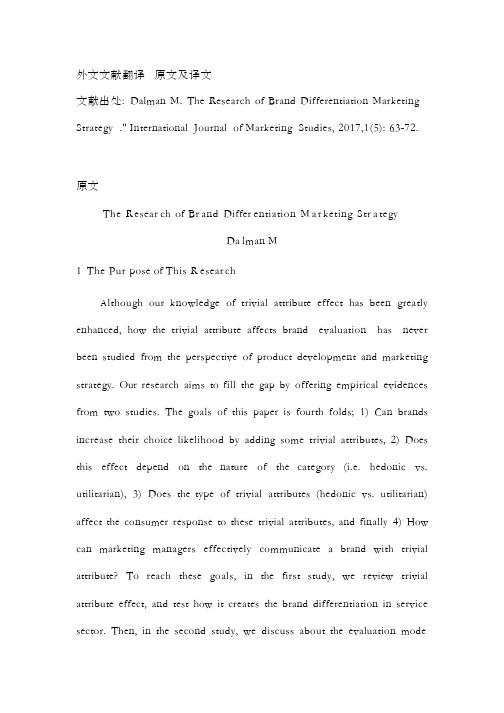
外文文献翻译原文及译文文献出处: Dalman M. The Research of Brand Differentiation Marketing Strategy ." International Journal of Marketing Studies, 2017,1(5): 63-72.原文The R esear ch of Br and Differ entiation M a r keting Str a tegyDa lman M1 The Pur pose of This R esear chAlthough our knowledge of trivial attribute effect has been greatly enhanced, how the trivial attribute affects brand evaluation has never been studied from the perspective of product development and marketing strategy. Our research aims to fill the gap by offering empirical evidences from two studies. The goals of this paper is fourth folds; 1) Can brands increase their choice likelihood by adding some trivial attributes, 2) Does this effect depend on the nature of the category (i.e. hedonic vs. utilitarian), 3) Does the type of trivial attributes (hedonic vs. utilitarian) affect the consumer response to these trivial attributes, and finally 4) How can marketing managers effectively communicate a brand with trivial attribute? To reach these goals, in the first study, we review trivial attribute effect, and test how it creates the brand differentiation in service sector. Then, in the second study, we discuss about the evaluation modeliterature, and test that the effect whether trivial attribute is more salient in joint evaluation or separate evaluation mode. Finally, we conclude with discussion and provide suggestions for further research.2.Theor etica l Ba ckgr oundTr ivia l Attr ibute Effect on Ser vice C hoiceTrivial attributes are defined as the attributes that do not create meaningful differentiation in evaluation of alternatives (Broniarczyk & Gershoff, 2003; Miljkovic et al., 2009). Consumers treat this trivial information in the advantage of brands that offer them even when they are informed before decision-making about the triviality (Carpenter et al., 1994). Brown and Carpenter (2000) explain this advantage with the reasons based account. They argue that consumers prefer to choose on the basis of easily justified, cognitively available reasons (Brown & Carpenter, 2000). Thus, when the options cannot be chosen based on important attributes, consumers need to rely on trivial attributes that create brand differentiation (Shafir, Simonson, & Tversky, 1993).The question about what to add to the offering to increase its value is especially important for services (Devlin, 1998), as it is more difficult to create a competitive advantage in service industries (Storey & Easingwood, 1998). The main reason is that unlike physical goods, services are intangible and consumers often face a problem of identifyingthe necessary attributes in services for evaluation. Thus, they end up only relying on brand comparisons on the basis of selected attributes (Gabott & Hogg, 1994; Rust & Chung, 2006). Therefore, services create more uncertainty for consumers than physical goods at the purchase stage.When a decision can't be justified on relevant attributes, consumers form arguments based on trivial attributes even after they are told about the triviality of the attribute (Albrecht, Neumann, Haber, & Bauer, 2011).Therefore, with the amount of uncertainty in services and the difficulty of evaluating attributes as mentioned above, consumers are likely to use trivial attributes when they are faced with an ambiguous choice set even after they are told about the triviality. We posit the hypothesis as follows;H1: The choice likelihood of service provider that offers a trivial attribute will be higher than that does not offer.Compared to physical goods, services are based on information processing (Rust & Chung, 2006) and how the information is processed depends on whether the service is utilitarian or hedonic (Hirschman & Holbrook, 1982). According to Batra and Ahtola (1991), consumers have these two motives in a choice context. Hedonic services are related to "fun" and "pleasure" (Babin, Darden, & Griffin, 1994) whereas utilitarian services are related to "functionality" (Strahilevitz & Myers, 1998). In a choice context, the outcomes of these two types of servicesare valued differently as the utilitarian outcome depends on objective standards whereas hedonic ones depend on subjective (discretionary) standards (Botti & McGill, 2010). Moreover, Botti and McGill (2010) argue that hedonic motives are sought "as an end itself" whereas utilitarian motives are used to reach a higher-level goal. We argue that utilitarian services are more anxiety provoking than hedonic services as they include important, harder to achieve, and uncertain goals (Lazarus, 1991). And in situations, when goals are anxiety provoking, trivial attributes are more influential (Xiao, Dacin, & Ashworth, 2011). Therefore, we expect the effect of trivial attributes to be more pronounced in a hedonic service category than in a utilitarian service category. We posit the hypothesis as follows:H2: The advantage of service provider that offers a trivial attribute will be more pronounced for the hedonic services compared to utilitarian services.M ar keting C ommunica tion Str a tegy Using Tr ivia l Attr ibute Effect Prior literature has suggested that comparison is a natural and powerful strategy that consumers often rely on (Cooke, Janiszewski, Cunha Jr, Nasco, &De Wilde, 2004; Dhar, Nowlis, & Sherman, 1999). Hsee and Leclerc (1998) suggest that consumer preference changesdepending on how products are presented and evaluated, specifically, whether they are evaluated separately (separate evaluation mode) or jointly (joint evaluation mode). For example, in separate evaluation when one is asked to rate the importance of supporting government intervention for saving dolphins over preventing skin cancer among farm works, the number of people who supports the government intervention for saving dolphins is substantial. However, in the joint evaluation mode when the same person is asked to compare the importance of dolphin to that of a human side by side (or jointly) the majority of people's answer is obvious to support a human.Thus, consumers in joint evaluation mode not only greatly save their efforts but also increase accuracy in choice because it is easier to identify similarities and differences between competing brands. This evaluation strategy focusing on the difference or something unique makes the trivial attribute become salient and even meaningful (Dhar& Sherman, 1996). Taken together, we posit that brand with trivial attribute will be perceived more valuable (i.e., people are willing to pay more) in the joint evaluation mode than it is in the separate evaluation mode.H3: Willingness to Pay (WTP) is higher in the joint evaluation mode than that in the separate evaluation mode.3.DiscussionCreating brand differentiation has been critical more than ever in our globalized world. Many manufactures of consumer package goods make enormous marketing efforts to differentiate their brands against competitors often by searching and adding new or noble attributes. An important decision to make for marketing managers is to determine what features should be included. In this research, we introduced an unusual brand differentiation strategy using the trivial attribute effect. Results from two experimental studies point out the following; if a trivial attribute as easy to implement as playing music in between class sessions for a GMAT course or distributing free ice at a Music Festival is offered, it can help service providers gain competitive advantage over their competitors. This can allow managers to be more creative and stay competitive in the market. Our results also indicate that this effect is more pronounced in hedonic service categories compared to the utilitarian categories.From the ethical perspective, offering attributes that don't create meaningful difference for consumers is not deceiving consumers as our results indicate that the effects of trivial attributes hold even after consumers are told about the triviality of them. Moreover, consumers indicated in our study that they are not only aware of the triviality of these attributes but they also think they are not useful in theirdecision-making. Another result we found that supports the triviality of these attributes is that the type of trivial attribute (hedonic / utilitarian) does not matter. Lastly, in terms of effective marketing communication strategy relying on trivial attribute effect, our results revealed that the joint evaluation mode increases the consumer's willingness to pay more than that of the separate evaluation mode.4.Implications and L imitationsOur research handles both theoretical and practical implications; theoretically it will add to the service literature the applicability of trivial attributes. While research on trivial attributes so far has mainly focused on different consumer goods including down jackets, compact disc players, pasta (Carpenter et al., 1994), coffee, and cologne (Brown & Carpenter, 2000), we are not aware of any research that has investigated trivial attributes in a service context. In our efforts to understand if using trivial attributes would have a differential effect on hedonic vs. utilitarian services, results suggest that consumers use different types of information evaluating hedonic vs. utilitarian services (Batra & Ahtola, 1991; Holbrook & Hirschman, 1982) when trivial attributes are evaluated.Managerially, it can show the managers a possibly easy way to gain competitive advantage over the competitors. Consider the music festival example above. Using an equipment from the place where the music wasoriginated is not necessarily the best nor the most expensive choice. However, it can possibly give the organizers the edge over the competitor festivals if people consider this information positively in their decision-making. Lastly, from the perspective of marketing communication strategy, attributes themselves can also be either utilitarian or hedonic and it will be up to the marketers to choose the type of the trivial attributes for their offerings. However, this becomes important only if this choice affects the consumer response to the offering a nd helps the marketerIn services, one of the main reasons why it is difficult to create and maintain advantage is the fact that in services, competitors can easily copy the aspects of successful offerings (Storey & Easingwood, 1998). This then puts pressure on service managers to stay competitive in the market place. Our research findings contribute to the service sector. Service sector compromises 68% of US GDP and 80% of the US jobs (Office of the US Trade Representative) and this distribution is similar in all developed countries as there is a positive correlation between GDP and the share of the service sector in an economy (Sherom & Saubbotina, 2000). While the service sector has such an important share in the economy, at the same time, service management is different from managing goods (Mittal, 1999; Parasuraman, Zeithaml, & Berry, 1985)and it is more difficult (Storey& Easingwood, 1998).Moreover, the consumer behavior for services is also different than it is for goods and it is more difficult for consumers to make a choice along the alternatives (Gabott & Hogg, 1994). In sum, all these factors about services make it an important domain to understand if companies can use trivial attributes to gain advantage in the marketplace and our research sheds light to managers in the service sector.译文品牌差异化营销策略研究达尔曼〃马库斯1 研究目的尽管我们对于微小属性的认识大大加强, 从产品开发和营销策略的角度来讲,微小属性如何影响品牌评估还尚未被研究过。
关于差异化营销策略研究报告的文献综述
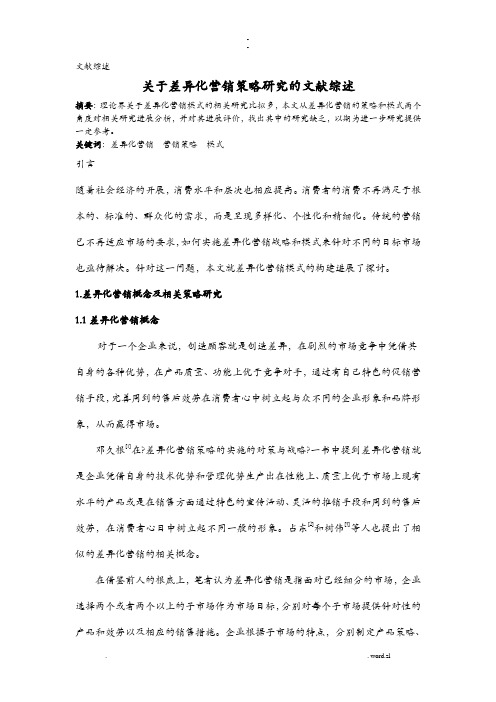
文献综述关于差异化营销策略研究的文献综述摘要:理论界关于差异化营销模式的相关研究比拟多,本文从差异化营销的策略和模式两个角度对相关研究进展分析,并对其进展评价,找出其中的研究缺乏,以期为进一步研究提供一定参考。
关键词:差异化营销营销策略模式引言随着社会经济的开展,消费水平和层次也相应提高。
消费者的消费不再满足于根本的、标准的、群众化的需求,而是呈现多样化、个性化和精细化。
传统的营销已不再适应市场的要求,如何实施差异化营销战略和模式来针对不同的目标市场也亟待解决。
针对这一问题,本文就差异化营销模式的构建进展了探讨。
1.差异化营销概念及相关策略研究1.1差异化营销概念对于一个企业来说,创造顾客就是创造差异,在剧烈的市场竞争中凭借其自身的各种优势,在产品质量、功能上优于竞争对手,通过有自己特色的促销营销手段,完善周到的售后效劳在消费者心中树立起与众不同的企业形象和品牌形象,从而赢得市场。
邓久根[1]在?差异化营销策略的实施的对策与战略?一书中提到差异化营销就是企业凭借自身的技术优势和管理优势生产出在性能上、质量上优于市场上现有水平的产品或是在销售方面通过特色的宣传活动、灵活的推销手段和周到的售后效劳,在消费者心目中树立起不同一般的形象。
占东[2]和树伟[3]等人也提出了相似的差异化营销的相关概念。
在借鉴前人的根底上,笔者认为差异化营销是指面对已经细分的市场,企业选择两个或者两个以上的子市场作为市场目标,分别对每个子市场提供针对性的产品和效劳以及相应的销售措施。
企业根据子市场的特点,分别制定产品策略、价格策略、渠道策略以及促销策略并予以实施。
1.2差异化营销策略研究关于差异化营销策略研究主要集中在产品、效劳、品牌和渠道等方面。
学界涌现出了大量的研究成果。
1.2.1产品差异化策略产品差异化是指产品的特征、工作性能、一致性、耐用性、可靠性、易修理性、式样和设计等方面的差异。
其缺点是保持产品的差异化往往以高本钱为代价,因为企业需要进展广泛的研究开发、产品设计、高质量原料和争取顾客支持等工作。
- 1、下载文档前请自行甄别文档内容的完整性,平台不提供额外的编辑、内容补充、找答案等附加服务。
- 2、"仅部分预览"的文档,不可在线预览部分如存在完整性等问题,可反馈申请退款(可完整预览的文档不适用该条件!)。
- 3、如文档侵犯您的权益,请联系客服反馈,我们会尽快为您处理(人工客服工作时间:9:00-18:30)。
文献综述关于差异化营销策略研究的文献综述摘要:理论界关于差异化营销模式的相关研究比较多,本文从差异化营销的策略和模式两个角度对相关研究进行分析,并对其进行评价,找出其中的研究不足,以期为进一步研究提供一定参考。
关键词:差异化营销营销策略模式引言随着社会经济的发展,消费水平和层次也相应提高。
消费者的消费不再满足于基本的、标准的、大众化的需求,而是呈现多样化、个性化和精细化。
传统的营销已不再适应市场的要求,如何实施差异化营销战略和模式来针对不同的目标市场也亟待解决。
针对这一问题,本文就差异化营销模式的构建进行了探讨。
1.差异化营销概念及相关策略研究1.1差异化营销概念对于一个企业来说,创造顾客就是创造差异,在激烈的市场竞争中凭借其自身的各种优势,在产品质量、功能上优于竞争对手,通过有自己特色的促销营销手段,完善周到的售后服务在消费者心中树立起与众不同的企业形象和品牌形象,从而赢得市场。
邓久根[1]在《差异化营销策略的实施的对策与战略》一书中提到差异化营销就是企业凭借自身的技术优势和管理优势生产出在性能上、质量上优于市场上现有水平的产品或是在销售方面通过特色的宣传活动、灵活的推销手段和周到的售后服务,在消费者心目中树立起不同一般的形象。
张占东[2]和杨树伟[3]等人也提出了相似的差异化营销的相关概念。
在借鉴前人的基础上,笔者认为差异化营销是指面对已经细分的市场,企业选择两个或者两个以上的子市场作为市场目标,分别对每个子市场提供针对性的产品和服务以及相应的销售措施。
企业根据子市场的特点,分别制定产品策略、价格策略、渠道策略以及促销策略并予以实施。
1.2差异化营销策略研究关于差异化营销策略研究主要集中在产品、服务、品牌和渠道等方面。
学界涌现出了大量的研究成果。
1.2.1产品差异化策略产品差异化是指产品的特征、工作性能、一致性、耐用性、可靠性、易修理性、式样和设计等方面的差异。
其缺点是保持产品的差异化往往以高成本为代价,因为企业需要进行广泛的研究开发、产品设计、高质量原料和争取顾客支持等工作。
企业要想取得产品差异,有时要放弃获得较高市场占有率的目标,因为它的排他性与高市场占有率是矛盾的[4]。
对产品差异化(Product Differentiation)问题的研究起始于二十世纪三十年代关于垄断竞争问题的讨论。
要完整地理解产品差异化,还必须明确产品的层次。
菲利普·科特勒[5] (Philip Kotler 1999,Marketing Management)在产品三层次模型的基础上提出了产品五层次模型,即核心产品(利益)、一般产品、期望产品、附加产品和潜在产品。
它说明产品价值和利益的形成过程具有双向性,是营销者与顾客共同作用的结果,并且由顾客起主导作用。
而顾客不在满足单一的产品。
正如美国著名营销专家哈佛大学教授西奥多·李维特[6]所言,现代竞争并不在于各公司在其工厂中生产什么,而在于他们能为其产品增加些什么内容诸如包装、服务、广告、客户咨询、融资、送货等方面的差异化来增加产品价值,以引起人们的重视,从而满足人们的差异化需求。
因此,找到合适的差异化要素,实施产品差异化策略,产品竞争就能顺利开展。
1.2.2服务差异化策略服务差异化是指企业向目标市场提供与竞争者不同的优异的服务。
尤其是在难以突出有形产品的差别时,竞争成功的关键常常取决于服务的数量与质量。
服务差异化的研究是从制造业开始的。
Houghton Pappas和Sheehan[7]认为,随着全球知识经济的到来,发达国家经济的产业构成、产业内部活动以及产业间关联都发生了变化,其中最明显的变化是“服务”变得日益重要。
当企业意识到可以通过不同的服务来增强自身产品竞争力时,许多企业甚至开始向服务转型以获取新的价值来源。
国内外学者(Berger,Lester,1997;Pappas、Sheehan,1998;Aegis,1999;Gann、Salter,2002)将这一现象称为“服务差异化” [8][9]。
服务差异化具有广泛的制造业行业分布性,从家电、汽车、机械制造业到制药业等。
面对这一新现象,西方学者主要集中在美国和澳大利亚以发达国家为背景,重点讨论了知识经济环境下制造业的发展道路问题,明确提出了“服务差异型产品”及“服务差异型制造业”等概念,并对服务差异的宏观表现、微观原理及模式等进行了性研究(Quinn1992;Aegis1999;Campell2002;S heehan2000)[10]。
国内学者如叶勤[11]、蔺雷、吴贵生[12]等也开始涉足这一领域,从各种角度探讨“服务差异化”对中国制造企业在全球化竞争中具有重要现实意义。
目前,服务差异化也开始涉足于食品行业。
采取服务差异化策略主要从两个方面展开:一个是不断提高顾客的满意度,另一个就是不断减少服务的成本。
要提高顾客的满意度,还得对顾客进行研究。
根据ISO9000:2000的(3.3.5)条款,对“顾客”的定义是“接受产品的组织或个人。
顾客的类型有消费顾客和商业顾客、中间顾客、公利顾客三大类[13]。
自从西奥多·莱维特(Thedore Levitt)、刁昳等人也提出“顾客满意(Customer Satisfaction)”这一概念。
美国商务部又在198 7年就设立了马尔科姆·鲍德里奇国家质量奖,而在其中七项标准中,“顾客满意”占了30%,位居第一位[14]。
2000年4月,中国政府有关部门对ISO质量认证的内容进行重新修订,在修订的八大原则上,“顾客满意”也位居第一原则[15]。
同时在寻找潜在顾客时佩尔图(Bilfredo Pareto)[16]提出了80/20定律,80/20定律不仅给市场、销售带来收益,使企业准确的把握市场,研发出具有市场占有力的产品,同时也可以作用于顾客服务这一层面,让企业在服务的基础上去分析顾客群体。
同时对顾客类型了解,并对其进行相应的差异服务,也可以减少服务的成本。
1.2.3促销差异化策略潘向光[17]和张晓琳 [18]在提出促销差异化营销的定义上不完全一致,但都提到了针对中间商或消费者,提供短程激励认为促销活动(SP,sales promotion)就是企业针对中间商或消费者,提供短程激励,促使消费者对企业及其产品(或服务)产生兴趣、好感与信任,进而做出购买决策的活动。
促销差异化的手段和作用有哪些呢?苗月新[19]在《市场营销学》一书中提到常见的促销有广告,产品展示会,公共关系和人员推销等。
同时指出促销差异化要以产品的特性为基础,以消费者的需求为中心,实现最大程度上的差异化。
促销差异化可以使企业树立差异化的形象,打造差异化的产品形象,同时可以增加顾客的价值和满意感,是差异化营销策略的重要一部分。
招汉宇[20]在促销《对整合营销中品牌建设影响研究》一书中提出了促销活动的作用。
通过促销可以使产品容易获得通路的注意及支持,增加零售店库存(降低竞争品之库存量),增加产品回转率,增加货架占有率;改善或扩大产品的普及率,鼓励和便利消费者购买,强化品牌接受度,对抗竞争品牌的活动;并且可替代或补强广告的不足,加速产品进入市场。
持续的促销活动可以培养消费者的购买习惯,直接提高销售额,并可带动关联产品的销售。
1.2.4品牌差异化营销策略菲利浦·科特勒[21]的观点,品牌是一种名称、标记、符号、标记或设计,及他们的组合应用,其目的是借以辨认某个销售或某群销售者的产品或服务,并使之同竞争对手的产品和服务区分开来。
品牌还是一项重要的无形资产,也可以转让盈利。
施振荣[22]在《品牌管理愿景与企业文化》一书中也提出了品牌的含义。
并强调注重商品在质量、性能、效用,以及品牌的市场定位、文化内涵的差异化营销。
品牌营销,简称是对企业创立的品牌进行设计、传播、销售、管理的计划和实施的过程,从而满足消费者价值最大化及实现企业的目标。
品牌也凭借着品牌营销的过程,实践了其自身的价值。
品牌营销可分为四部分,即品牌个性、品牌传播、品牌销售和品牌管理[23]。
迈克尔·波特(Michael Porter)[24]认为差异化造就了品牌,差异化的策略有助于品牌的形成和提升,品牌是差异化的结果,同时品牌也形成了差异化。
所以差异化和品牌是密切关联,相辅相成的。
品牌是一个企业生存的关键,品牌本身就是一种差异。
一种很普通没有特色的产品是不可能成为品牌,差异化造就了品牌,差异化的策略有助于品牌的形成和提升,品牌是差异化的结果。
同时品牌也形成了差异化,所以差异化和品牌是密切关联,相辅相成的。
品牌差异化包括品牌的差异化定位、品牌差异化传播、细分市场再造辉煌等。
1.2.5渠道差异化营销策略Louis.W.Stern[25]在《市场营销渠道》一书中提到营销渠道是指产品从制造者手中转至消费者手中所经过的各个中间连接起来的通道,它由位于起点的生产者和位于终点的消费者,以及位于两者之间的各类中间组成。
在营销渠道的功能方面,劳伦斯·G·弗里德曼和R·弗瑞[26]认为有其便利搜寻、调节品种与数量差异和提供服务。
实现了产品从生产者向消费者的转移。
邱莉红[27]在《对营销渠道绩效评估的探讨》一书中曾提到实施差异化营销渠道有利于企业确立外在的优势增强企业的竞争力,建立企业和消费者的良好关系。
可见,差异化的营销渠道是以顾客的需求为中心和了解目标顾客的需求。
同时分析竞争对手的渠道结构和策略,根据自己产品的特性和企业自身的情况如实力、发展目标等来寻找差异化的渠道。
从而获得产品市场,增强产品竞争力。
综上,差异化营销策略的意义和作用得到了广大研究学者一致认同。
研究者关于如何采取以及采取什么样的差异化营销策略研究比较多。
这部分研究的前提是差异化的最终目的是为了满足顾客需求。
因此,研究者的研究思路基本上都是如何寻找差异化。
但是顾客的需求是在不断变化的,也是可以被引导和开发的。
从这个角度看,理论界关于如何创造、培养、发展差异化来满足顾客需求的研究就相对比较少。
2.国内外差异化营销相关模式概况2.1差异化产品竞争模型从差异化产品竞争的含义出发,必须找到合适的差异化要素,产品竞争才可能顺利开展,夏春阳[28]认为,从产品层次角度进行产品差异化是一个有效的途径,在此基础上提出了差异化产品竞争模型,模型包括四个要件:概念差异化、属性差异化、品牌差异化和服务差异化。
营销定位理论鼻祖Al·Ries和Jack·Trout[29]也提到了概念差异化。
指出市场营销实际上是概念之间的竞争,而不是产品之间的竞争。
这一理论从另一个角度说明了产品竞争的核心问题。
有产品无概念,产品可能始终成不了商品,有概念没产品,概念本身照样可以成为商品。
产品概念的竞争只是产品竞争的一个方面,也是深层次的产品竞争[30]。
